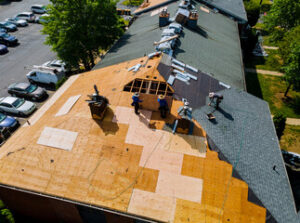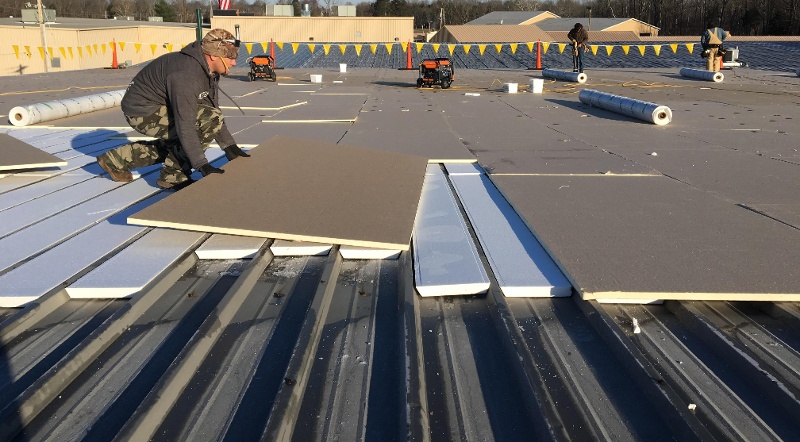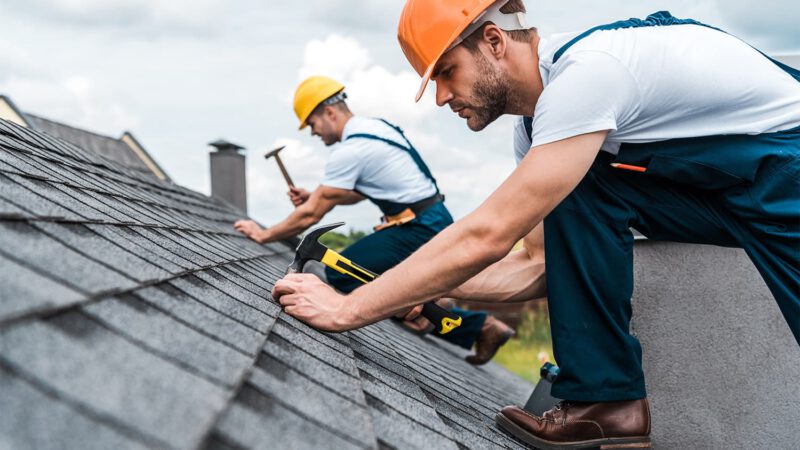The Importance of Roofing Maintenance
The roof is your home’s biggest protector from the elements. It’s important to perform regular maintenance to keep it in good shape.
Surface maintenance includes identifying shingle damage and leaks, cleaning gutters, and removing debris. It also involves inspecting and repairing sealant, flashing, and chimneys. Visit fivestarroofingandcontracting.com to learn more.
In addition, you should regularly check attic ventilation and insulation for energy efficiency optimization.
 Flashing is sheet metal fabricated into a shape designed to prevent water from penetrating the roof system. It’s placed around areas of the roof that are most likely to leak, including chimneys, skylights, vent pipes, valleys and joints. If moisture gets past the flashing, it can cause serious structural damage and mold. A regular inspection of the flashing is important to make sure it’s doing its job.
Flashing is sheet metal fabricated into a shape designed to prevent water from penetrating the roof system. It’s placed around areas of the roof that are most likely to leak, including chimneys, skylights, vent pipes, valleys and joints. If moisture gets past the flashing, it can cause serious structural damage and mold. A regular inspection of the flashing is important to make sure it’s doing its job.
Flashing often has caulk surrounding it, which helps seal the gap between the roof and the metal flashing. Inspect for cracks, pitted spots or missing beads and apply new caulk if necessary. In some cases, the flashing itself is sealed with a rubber roofing membrane. Inspect for peeling or deterioration and replace the membrane as needed.
Some flashing is installed with screws that anchor it into place. During an inspection, look for loose or pulling out screws and check the condition of the metal around the screw head. If the metal is corroded, it will need replacement as soon as possible. In addition, the screws should be made of a material that is compatible with the roof sheeting.
Inspect for rust and corrosion on the flashing itself and around the edges of the flashing. This can be caused by exposure to the elements, but can also happen if the flashing is painted. If the rust is severe, it will need to be replaced immediately to avoid damage to the roof and the inside of the home.
Check that the flashing is securely fastened to the roof and the screw heads are covered with roofing cement. Also inspect for a smooth and even seal on the seams of the flashing.
During an inspection, pay special attention to the flashing at any penetrations in the roof such as chimneys, skylights and vents. Inspect for signs of leaks at these points, such as water stains in the ceiling or walls. If the leak is due to flashing not being adequately sealed, it can be easily repaired with roofing cement.
If you can’t safely inspect the flashing from a ladder, try using binoculars or a camera to zoom in on the area. If you spot a problem, be sure to include a note in your report.
Inspect the Gutters
Gutter systems are designed to capture and channel rainwater runoff away from the roof, preventing damage to the roof and foundation. Clogged or damaged gutters, on the other hand, can lead to spilling, pooling, and leakage that can damage the roof, walls, and house structure. Regular inspections help identify issues and prevent them from escalating into costly repairs.
Perform a Visual Inspection
Begin your inspection with a visual check of the gutters to look for blockages, rust spots, or other signs of wear and tear. If you can spot water stains or overflowing spots on the wall below the gutters, these are indications that your gutter system needs cleaning or repair.
A good rule of thumb is to inspect your gutters twice a year to ensure that they’re functioning properly. During the first inspection, make sure the gutters are free of debris and that the downspouts are clear. If you spot any leaking spots, these should be repaired with gutter sealant.
Next, check to make sure the gutters are sloped correctly. If you see that the gutters are sagging or pulling away from the building, it may be time to replace them. A professional can assist you with identifying the best replacement method and implementing it.
Conduct a Functional Test
After you’ve performed a visual and close-up inspection, use a garden hose to run water through the gutters. Begin at the end farthest from the downspout and work your way towards it to see if water flows freely. If water is flowing through your gutters but doesn’t reach the downspout, it may be time to install additional downspouts or reposition existing ones. You should also pay attention to any areas of standing water as these could indicate that the gutters are leaking or that the slope of the gutters isn’t adequate. If the gutters are leaking, these issues should be addressed immediately to prevent them from escalating into costly water damage.
Inspect the Shingles
The shingles on your roof shield your home from the elements. When they become damaged, your home is exposed to water damage and the underlying materials can be compromised. Inspecting your shingles regularly helps you find damage before it becomes a major problem and saves you money in the long run. If you do not feel comfortable climbing on your roof, you can also perform a visual inspection with a pair of binoculars from the safety of the ground.
Look for shingles that are cracked, broken, or missing. If you notice any of these issues, it is important to call in a professional roofing contractor for an assessment and repairs. Missing shingles are one of the most obvious signs of roof damage and should be immediately addressed. In addition, if you see areas of your roof that have dark spots or are covered with moss, it is likely due to moisture and requires immediate attention.
Cracked shingles are another common sign of wind damage. These shingles will need to be replaced and may lead to leaks and other problems. The best way to prevent this issue is by replacing your shingle with a high-quality, wind-resistant shingle.
Blistering shingles are also a sign of roof damage. These shingles are often a result of moisture and will need to be replaced. The best way to prevent this is by making sure your gutters are free of debris and that there are no cracks or gaps in your roof or the flashing.
The highest points on your roof, including ridge lines and peaks, are especially susceptible to wind damage. This area of your roof is not only more exposed to the weather, but it can also be harder to repair because it’s difficult to reach with a ladder. This is a key area to pay special attention to during your roof inspections, as any damage in this area can quickly spread throughout the rest of the roof.
If you spot any signs of wind-damaged shingles, call in a roofing contractor for an assessment and repair. They can provide detailed documentation of the damage for insurance claims and ensure that any damages are appropriately repaired or replaced.
Trim Trees
Keeping trees, shrubs and ground landscaping well-trimmed can prevent debris from accumulating on the roof, promote proper gutter flow, reduce the load on the roofing membrane and help prevent moisture and structural damage to the home. Additionally, it is important to trim tree limbs that hang too close to the house. During heavy storms, loose or hanging branches can break and fall on the roof or other parts of the home, which can lead to roof damage and water leaks.
To prune a tree properly, it is important to begin at the top and work down. This allows for better shaping of the tree and saves time in clearing the area after pruning. When pruning, it is recommended to make clean cuts with sharp tools. This prevents the spread of disease and rot and helps the tree heal faster. It is also important to avoid stubs, which may not heal well and can cause damage when the weather turns cold.
The main branch (scaffold) branches of a tree should be well-spaced and evenly distributed around the crown. This will ensure a strong, healthy tree and a good form. It is best to choose branches with wide-angle crotches, as opposed to V-shaped crotches, which are weaker and more susceptible to damage in wind storms.
It is also important to remove water sprouts and suckers, which are shoots that grow from the trunk or rootstock of a tree rather than the main stem. They can detract from the appearance of a mature tree and are prone to breaking off during high winds. Summer pruning is an excellent time to remove these.
During a roof inspection, it is also common for a contractor to check the condition of tree limbs that are causing problems. This includes removing limbs that have fallen from trees during a storm, examining the branches for signs of pest infestation, checking the drains to make sure they are clear of debris and water-testing to ensure they are working properly. This is especially important in areas that experience frequent or severe rainstorms.


